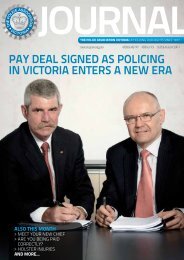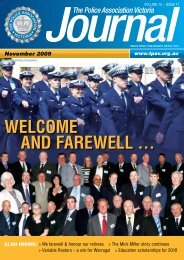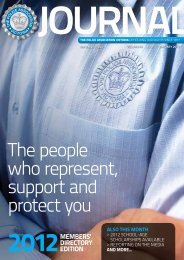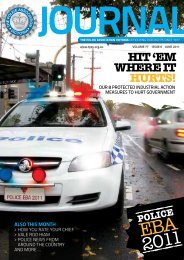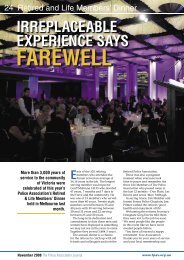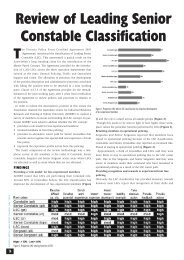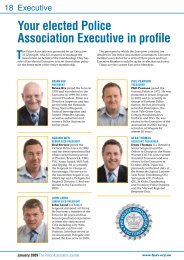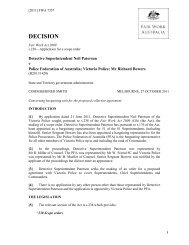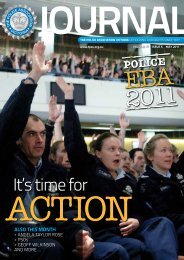August 2009 - The Police Association Victoria
August 2009 - The Police Association Victoria
August 2009 - The Police Association Victoria
Create successful ePaper yourself
Turn your PDF publications into a flip-book with our unique Google optimized e-Paper software.
21<br />
George Lawton Mayman – photo – Australian War Memorial negative number DAOD1702.<br />
not initially include meeting<br />
minutes, financial reports or<br />
anything that might remotely be<br />
considered political or controversial.<br />
<strong>The</strong> secretary and nominal<br />
journal editor was First Constable<br />
G. Bunting, a clerk in the Russell<br />
Street Superintendent’s Office.<br />
Contributions to the journal were<br />
collated by him and vetted by a<br />
‘Journal Committee’.<br />
<strong>The</strong> actual editor of the ‘new’<br />
Journal from 1931 to 1937 was<br />
George Lawton Mayman, a lawyer<br />
and author, who as well as editing<br />
the Law Institute Journal was a<br />
member of the <strong>Police</strong> Practical<br />
Examinations Board and a<br />
law lecturer for <strong>Victoria</strong> <strong>Police</strong><br />
promotion examinations. A former<br />
lieutenant in the AIF, who had<br />
served in France and was wounded<br />
in action during the First World<br />
War, Mayman’s tenure as editor<br />
ended with the controversial<br />
resignation of Chief Commissioner<br />
Thomas Blamey.<br />
Following the departure of<br />
Mayman the <strong>Association</strong> reverted to<br />
the practice of engaging a serving<br />
member as honorary journal editor<br />
and the first such appointee was<br />
Senior Constable Samuel James<br />
Williams, V.B., who formed part of<br />
a ‘ Journal Committee’ comprised<br />
of five <strong>Association</strong> members.<br />
He was followed by a succession of<br />
honorary editors who were serving<br />
police and who usually, but not<br />
always, also filled the position<br />
of secretary.<br />
Apart from a brief publishing gap<br />
in 1996, the break in publication<br />
engineered by Blamey in 1931 is<br />
the only time that publication<br />
of the journal has been seriously<br />
interrupted. And although the<br />
‘new’ journal was effectively an<br />
instrument of police command,<br />
that management stranglehold<br />
gradually dissipated following<br />
Blamey’s departure and the journal<br />
reverted to its original purpose<br />
of being the official <strong>Association</strong><br />
news magazine.<br />
In keeping with changed<br />
readership expectations, the<br />
journal over recent decades has<br />
eschewed the publication of items<br />
that an increasingly sophisticated<br />
readership might regard as<br />
offensive or twee. Long gone are the<br />
published references to indigenous<br />
Australians as ‘half-castes’ and<br />
articles decrying moves towards<br />
granting ‘equality to women’;<br />
which were frequently accompanied<br />
by sexist jokes. Little did the authors<br />
of these missives know that one day<br />
the Chief Commissioner and the<br />
editor of the journal would both<br />
be female.<br />
<strong>The</strong>re was a time when the<br />
only journal space allocated to<br />
women police carried the heading<br />
‘Household Page’ and the by-line,<br />
‘Conducted by <strong>Police</strong>woman Smith’.<br />
Contributed by <strong>Police</strong>woman<br />
Constable Lily Smith, the regular<br />
column never mentioned police<br />
work but was a collection of recipes<br />
for such delights as ‘Strawberry<br />
Bavarian Cream’.<br />
Much to the chagrin of some<br />
librarians and researchers the<br />
journal has over the decades<br />
undergone no fewer than nine<br />
subtle name changes and changes<br />
to volume series numbers and<br />
paper sizes. But such considerations<br />
have been of little relevance to<br />
regular readers who have seen the<br />
journal grow immeasurably in style<br />
and content.<br />
May 2008<br />
TOO BIG,<br />
TOO LOUD<br />
TO IGNORE<br />
ALSO INSIDE:<br />
VOLUME 74 – ISSUE 5<br />
www.tpav.org.au<br />
Historic rally > thousands of police march on Parliament House > Resourcing woes in Geelong<br />
A separation of the roles of secretary<br />
and editor enabled the employment<br />
of a suitably qualified civilian<br />
editor: the first of these in 1996 was<br />
Shirley Hardy-Rix, whose tenure as<br />
editor is the longest in the history<br />
of the journal. Improvements to<br />
the journal in recent decades have<br />
included the extensive use of full<br />
colour images and an increased<br />
focus on articles of particular<br />
industrial relevance to the<br />
<strong>Association</strong> and its members.<br />
Now in the 91 st year of publication,<br />
the journal has informed and<br />
entertained readers through two<br />
world wars, a police strike, Blamey’s<br />
<strong>Association</strong> coup and a multitude<br />
of other major events that have<br />
impacted both positively and<br />
adversely upon the activities of<br />
the <strong>Association</strong>. In all respects ‘the<br />
journal’ has more than fulfilled<br />
the aspirations of its founders who<br />
wanted ‘a newspaper of their own’.<br />
Dr Robert Haldane<br />
– <strong>Police</strong> Historian<br />
PRINT POST APPROVED PP337586/00076<br />
www.tpav.org.au <strong>The</strong> <strong>Police</strong> <strong>Association</strong> Journal <strong>August</strong> <strong>2009</strong>



